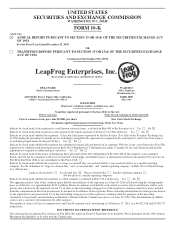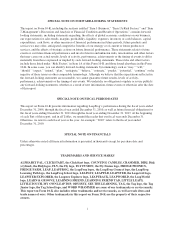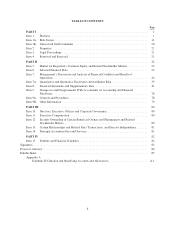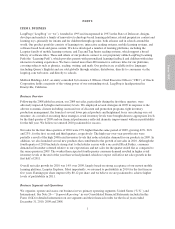LeapFrog 2010 Annual Report Download - page 15
Download and view the complete annual report
Please find page 15 of the 2010 LeapFrog annual report below. You can navigate through the pages in the report by either clicking on the pages listed below, or by using the keyword search tool below to find specific information within the annual report.
competitive advantages and differentiation, they are increasing their investments in product research and
development and advertising, focusing on global product launches and key distribution channels, expansion of
retail shelf space and expansion of products sold through the web. Our principal competitors have included
Mattel, Inc., primarily under its Fisher-Price brand, Hasbro, Inc. and its Playskool division, and Vtech Holdings
Ltd. For information on how competition could affect our business, see Part I, Item 1A.—Risk Factors— “If we
are unable to compete effectively with existing or new competitors, our sales and market share could decline.”
As our product strategy has developed, we increasingly face a broader competitive arena with a variety of
products including computer products, electronic and online games, interactive gaming systems and e-book
readers. Products in our mobile learning category, such as our Leapster platform and related software, compete
against handheld and console-based gaming platforms from Sony, Nintendo, Apple’s iPhone, iTouch and iPad,
and other mobile platforms and games and other software produced for these platforms. Online gaming and
learning is also increasingly becoming a factor in our competitive environment.
Our products must also compete for the leisure time of children and the discretionary spending of parents with
other forms of media and entertainment. We design our products to bring fun to learning in order to compete
favorably with these outside competitive influences.
Manufacturing
We are committed to designing and manufacturing products that meet applicable safety and regulatory
requirements. As is the case with most toy manufacturers and many consumer electronics companies, most of our
products are manufactured in China. We actively manage our supplier base, mandating compliance with local
and international safety inspections and reinforcing our product standards. These standards require meeting or
exceeding all applicable regulatory requirements regarding safety in the design, manufacture, packaging, and
delivery into the hands of each product’s ultimate user, a child.
Our manufacturing and operations strategy is designed to maximize the use of outsourced services, particularly
with respect to the actual production and physical distribution of our products. We outsource substantially all of
our manufacturing, using several Asian manufacturers, most of which manufacture our products at facilities in
the Guangdong province in the southeastern region of China. These manufacturers are selected based on their
technical and production capabilities and are matched to particular products to achieve cost and quality
efficiencies. We depend on these manufacturers to produce sufficient volumes of our finished products in a
timely fashion, at satisfactory cost and quality levels, and in accordance with our and our customers’ terms of
engagement. Since the fourth quarter of 2009, commodity and labor costs in China have increased due to a
variety of factors, including tightening Chinese labor markets, delays in ramping up production of raw materials
to meet growing demand for finished goods, and the revaluation of Chinese currency to permit it to rise in value
versus the U.S. dollar, leading to increased prices for us with some of our contract manufacturers. We expect to
be able to mitigate these increases to some degree in 2011 by shifting to lower-cost contract manufacturers and
pursuing cost-improvement projects, and we will be continually seeking ways to address this trend. For
information on the potential business risk for us from relying on contract manufacturers, see Part I, Item 1A.—
Risk Factors—“We rely on a limited number of manufacturers, virtually all of which are located in China, to
produce our finished products, and our reputation and operating results could be harmed if they fail to produce
quality products in a timely and cost-effective manner and in sufficient quantities.”
We have established subsidiaries in Hong Kong and Shenzhen, China to work closely with the contract
manufacturing service providers. These subsidiaries manage the supply of raw materials, labor and the assembly
process.
Most of our products are manufactured from basic raw materials such as plastic and paper, and the majority of
our products require electronic components. These raw materials are readily available from a variety of sources,
but may be subject to significant price fluctuations. Some of the electronic components used to make our
5
























